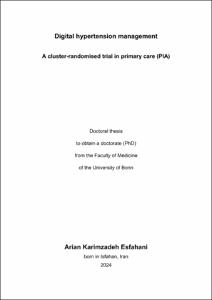Karimzadeh Esfahani, Arian: Digital hypertension management : A cluster-randomised trial in primary care (PIA). - Bonn, 2024. - Dissertation, Rheinische Friedrich-Wilhelms-Universität Bonn.
Online-Ausgabe in bonndoc: https://nbn-resolving.org/urn:nbn:de:hbz:5-74161
Online-Ausgabe in bonndoc: https://nbn-resolving.org/urn:nbn:de:hbz:5-74161
@phdthesis{handle:20.500.11811/11254,
urn: https://nbn-resolving.org/urn:nbn:de:hbz:5-74161,
doi: https://doi.org/10.48565/bonndoc-204,
author = {{Arian Karimzadeh Esfahani}},
title = {Digital hypertension management : A cluster-randomised trial in primary care (PIA)},
school = {Rheinische Friedrich-Wilhelms-Universität Bonn},
year = 2024,
month = jan,
note = {Introduction: Arterial hypertension is a significant risk factor for cardiovascular diseases and the leading cause of mortality and morbidity worldwide. Despite the widespread availability of effective treatment, control of hypertension in Germany still needs to be improved. The main reasons are barriers to guideline implementation in the clinical setting, poor adherence, and organisational failure. International studies showed that blood pressure (BP) control could be optimised through a digital-based hypertension management and delegation model to non-physician staff. In the PIA study we developed and evaluated such an intervention (PIA-Intervention). The PIA-Intervention includes a data protection-compliant system (PIA information communication technology: PIA-ICT) as well as eLearning for GP practices and patients. The PIA-ICT enables the communication between patients and practices, transmission and monitoring of BP values, customisation and transmission of medication plans, and prescription ordering.
Methods: The effectiveness of the PIA-Intervention was evaluated in a clusterrandomised controlled trial. GP practices were randomly assigned (1:1) to the intervention or control group (usual care). The primary outcome was a BP control rate (BP < 140/90 mmHg) after 6 - 12 months. Secondary outcomes were BP changes, PIA-ICT satisfaction, PIA-ICT use frequency, and blood pressure self-measurement and medication changes.
Results: The effectiveness of the PIA-Intervention was evaluated in 47 GP practices and 525 patients (Intervention 265; Control 260). There was a significant increase in BP control rates in the intervention group compared to the control group (59.9 % versus 36.7 %), which corresponds to an improvement of 23.1 % points (adjusted). Patients, GPs and practice assistants were very satisfied with the PIA-ICT and used the system frequently. The PIA-Intervention also led to a significant increase in the frequency of selfmeasurements and the average number of antihypertensives prescribed.
Discussion: Given the high effectiveness and acceptance among patients and health professionals, implementing the PIA-Intervention in usual care is reasonable. Calculated for nationwide implementation of the PIA-Intervention and assuming a population-wide reduction of systolic BP by 5.6 mmHg, 3.05 billion euros could be saved in statutory healthcare costs.},
url = {https://hdl.handle.net/20.500.11811/11254}
}
urn: https://nbn-resolving.org/urn:nbn:de:hbz:5-74161,
doi: https://doi.org/10.48565/bonndoc-204,
author = {{Arian Karimzadeh Esfahani}},
title = {Digital hypertension management : A cluster-randomised trial in primary care (PIA)},
school = {Rheinische Friedrich-Wilhelms-Universität Bonn},
year = 2024,
month = jan,
note = {Introduction: Arterial hypertension is a significant risk factor for cardiovascular diseases and the leading cause of mortality and morbidity worldwide. Despite the widespread availability of effective treatment, control of hypertension in Germany still needs to be improved. The main reasons are barriers to guideline implementation in the clinical setting, poor adherence, and organisational failure. International studies showed that blood pressure (BP) control could be optimised through a digital-based hypertension management and delegation model to non-physician staff. In the PIA study we developed and evaluated such an intervention (PIA-Intervention). The PIA-Intervention includes a data protection-compliant system (PIA information communication technology: PIA-ICT) as well as eLearning for GP practices and patients. The PIA-ICT enables the communication between patients and practices, transmission and monitoring of BP values, customisation and transmission of medication plans, and prescription ordering.
Methods: The effectiveness of the PIA-Intervention was evaluated in a clusterrandomised controlled trial. GP practices were randomly assigned (1:1) to the intervention or control group (usual care). The primary outcome was a BP control rate (BP < 140/90 mmHg) after 6 - 12 months. Secondary outcomes were BP changes, PIA-ICT satisfaction, PIA-ICT use frequency, and blood pressure self-measurement and medication changes.
Results: The effectiveness of the PIA-Intervention was evaluated in 47 GP practices and 525 patients (Intervention 265; Control 260). There was a significant increase in BP control rates in the intervention group compared to the control group (59.9 % versus 36.7 %), which corresponds to an improvement of 23.1 % points (adjusted). Patients, GPs and practice assistants were very satisfied with the PIA-ICT and used the system frequently. The PIA-Intervention also led to a significant increase in the frequency of selfmeasurements and the average number of antihypertensives prescribed.
Discussion: Given the high effectiveness and acceptance among patients and health professionals, implementing the PIA-Intervention in usual care is reasonable. Calculated for nationwide implementation of the PIA-Intervention and assuming a population-wide reduction of systolic BP by 5.6 mmHg, 3.05 billion euros could be saved in statutory healthcare costs.},
url = {https://hdl.handle.net/20.500.11811/11254}
}






